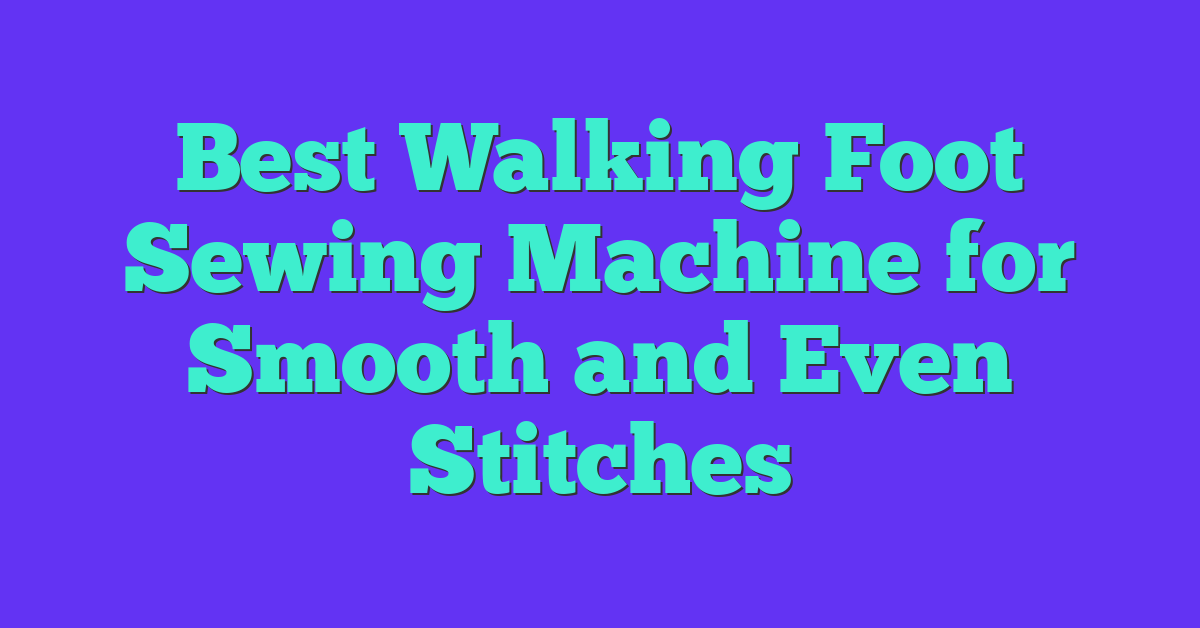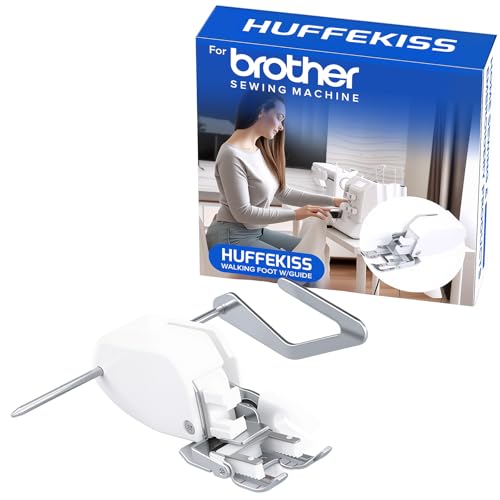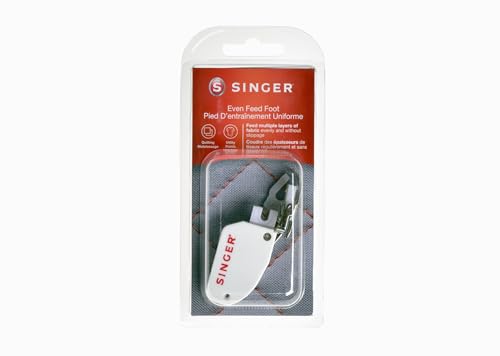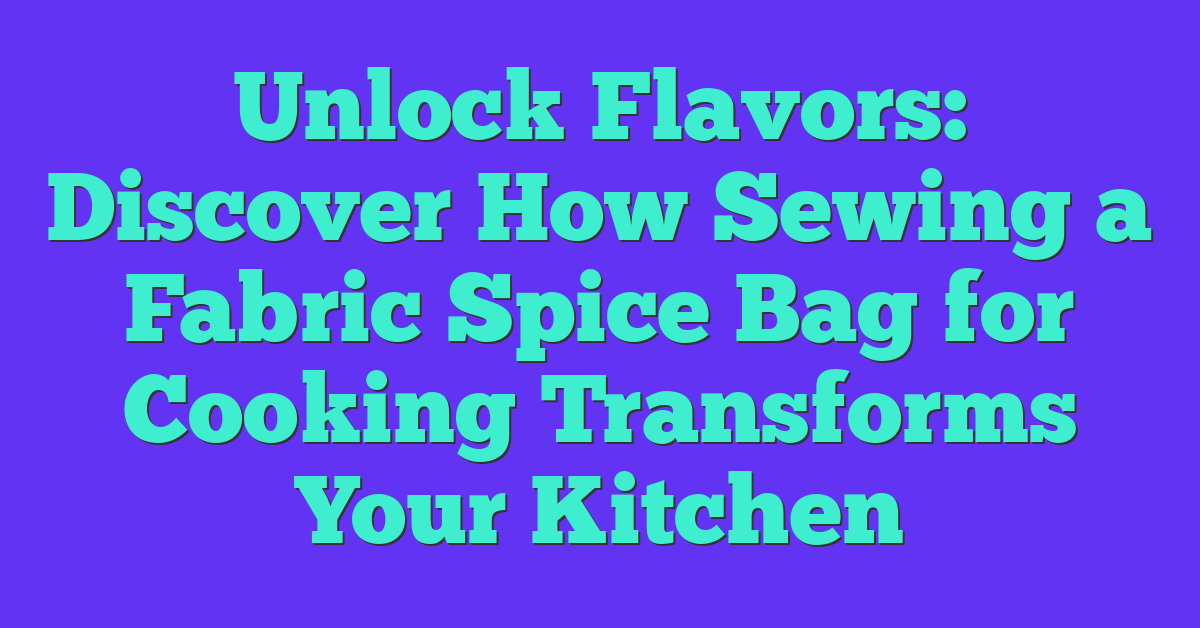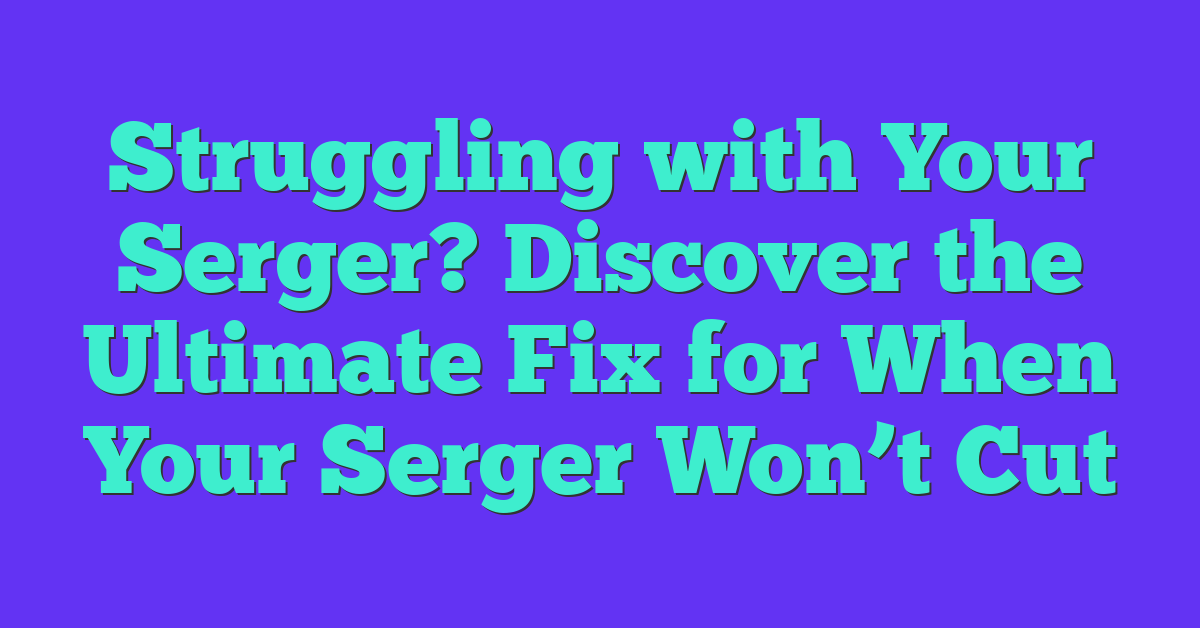As a sewing enthusiast, I understand the importance of having the right tools for the job. One of the most crucial tools in any sewing project is the sewing machine. When it comes to heavy-duty sewing, a walking foot sewing machine is the way to go. These machines have a unique mechanism that grips the fabric from the top and bottom, ensuring that it moves through the machine evenly. This makes them ideal for sewing thick fabrics, leather, and multiple layers of fabric.
In this article, I will provide you with a comprehensive guide to the best walking foot sewing machines on the market. I will cover everything from understanding how walking foot sewing machines work to the top picks for the best machines, features to consider when buying, sewing different materials, budget-friendly options, industrial vs. domestic machines, maintenance and durability, and ease of use. Whether you are a beginner or an experienced sewer, this guide will help you find the perfect walking foot sewing machine for your needs.
Key Takeaways
- Walking foot sewing machines are essential for heavy-duty sewing projects.
- When choosing a walking foot sewing machine, consider the features, materials you will be sewing, and your budget.
- The top picks for the best walking foot sewing machines include machines from Janome, Juki, Consew, and Reliable.
Understanding Walking Foot Sewing Machine
As someone who has been sewing for years, I can tell you that a walking foot sewing machine is a game changer. If you’ve never used one before, you might be wondering what makes it so special. Let me break it down for you.
A walking foot sewing machine is a type of sewing machine that has a built-in walking foot. This foot helps feed multiple layers of fabric through the machine evenly, preventing the top layer from shifting or puckering. This is especially helpful when working with thick or heavy fabrics like leather or denim.
One of the key features of a walking foot machine is the ability to move the fabric layers together. The walking foot, also known as a “dual feed” system, pulls the top and bottom layers of fabric through the machine at the same time. This means that the fabric layers stay aligned, which is essential for achieving a professional-looking finish.
Another benefit of using a walking foot machine is that it can save you time and frustration. When working with multiple layers of fabric, it can be difficult to keep everything aligned. This can result in uneven seams or fabric that shifts as you sew. With a walking foot machine, you can sew with confidence, knowing that the fabric will stay in place.
When shopping for a walking foot machine, there are a few things to keep in mind. First, consider the types of projects you’ll be working on. If you’ll be sewing heavy fabrics, look for a machine with a powerful motor and sturdy construction. If you’ll be doing a lot of quilting, look for a machine with a large throat space and a variety of stitch options.
Overall, a walking foot sewing machine is an excellent investment for anyone who wants to take their sewing to the next level. Whether you’re a beginner or an experienced seamstress, this type of machine can help you achieve professional-looking results with ease.
Top Picks for Best Walking Foot Sewing Machine
When it comes to finding the best walking foot sewing machine, there are several options available that can get the job done. However, after thorough research and testing, I have narrowed down the top picks for the best walking foot sewing machines on the market.
Consew 206RB-5
The Consew 206RB-5 is a popular choice among professionals in the upholstery and leatherworking industries. This walking foot industrial sewing machine is known for its durability and precision, making it an excellent choice for heavy-duty projects. It has a maximum sewing speed of 3,000 stitches per minute and can handle materials up to 3/8 inch thick.
Juki DNU-1541
Another popular choice for professionals is the Juki DNU-1541. This walking foot industrial sewing machine is known for its reliability and ease of use. It has a maximum sewing speed of 2,500 stitches per minute and can handle materials up to 3/8 inch thick. The Juki DNU-1541 also has a large bobbin capacity, which means less time spent changing bobbins.
Brother CS6000i
If you’re looking for a walking foot sewing machine for home use, the Brother CS6000i is a great option. This budget-friendly machine has a walking foot attachment available and is known for its versatility. It has 60 built-in stitches, an automatic needle threader, and a wide table for larger projects.
REX 607Z Portable
The REX 607Z Portable is a compact and lightweight option for those who need a walking foot sewing machine on-the-go. This machine is perfect for small projects and has a maximum sewing speed of 750 stitches per minute. It can handle materials up to 4 layers of denim and comes with a variety of accessories.
Reliable 4000SW
The Reliable 4000SW is a heavy-duty walking foot sewing machine that can handle materials up to 7/8 inch thick. It has a maximum sewing speed of 2,000 stitches per minute and comes with a variety of accessories, including a table and motor. The Reliable 4000SW is a great option for professionals in the upholstery and leatherworking industries.
After testing and researching these walking foot sewing machines, I believe they are the top picks for their respective categories. Whether you’re a professional or a hobbyist, these machines can handle a variety of projects and materials with ease.
Features to Consider When Buying
When looking for the best walking foot sewing machine, there are several features to consider. As someone who has spent a lot of time sewing and researching sewing machines, I have found that the following features are important to consider when making a purchase:
Sewing Speed and Motor
One of the most important features to consider is the sewing speed and motor. A powerful motor is essential for sewing through multiple layers of fabric and heavy materials. A servo motor is a great option for those who want a quieter machine that can sew at different speeds. Additionally, a speed reducer can help control the speed of the machine, making it easier to sew at a consistent pace.

Feeding Mechanism
The feeding mechanism is another important feature to consider. A triple feed or rectangular feed system can help ensure that the fabric is fed evenly through the machine, preventing bunching or stretching. Additionally, a walking foot machine with a drop feed or needle feed can help control the fabric even more.
Needle and Stitching
The needle and stitching options are also important to consider. A machine with a single needle is great for basic sewing, while a machine with a zigzag stitch can add versatility. Additionally, an extra-long stitch option can be useful for quilting or other projects that require longer stitches.
Durability and Parts
When investing in a walking foot sewing machine, it’s important to consider the durability and availability of parts. Look for a machine with a durable frame and components that can withstand heavy use. Additionally, make sure that replacement parts are readily available in case something needs to be repaired.
Size and Height
Finally, consider the size and height of the machine. A machine with an adjustable height can make it easier to sew comfortably, especially for those who are taller or shorter than average. Additionally, a machine with a long arm and large bed size can be useful for working with larger pieces of fabric.
« Best Walking Foot Industrial Sewing Machines for Heavy Duty Sewing
Sewing Needle Sizes: A Guide to Choosing the Right Size »
Overall, when looking for the best walking foot sewing machine, consider the sewing speed and motor, feeding mechanism, needle and stitching options, durability and parts, and size and height. By taking these features into account, you can find a machine that meets your needs and helps you create beautiful, high-quality projects.
Sewing Different Materials
As a sewing enthusiast, I know that different materials require different techniques and tools. When it comes to sewing with a walking foot, it’s important to consider the type of material you’ll be working with. Here are some tips for sewing different materials with a walking foot sewing machine.
Leather
Sewing leather requires a special type of needle and thread, as well as a walking foot sewing machine. The walking foot helps to prevent the leather from slipping and ensures that the stitches are even. When sewing leather, it’s important to use a longer stitch length and avoid backstitching, as it can weaken the leather.
Fabric
When sewing with lightweight fabrics, like cotton or silk, a walking foot can help to prevent the fabric from shifting and puckering. It’s also helpful when sewing multiple layers of fabric together. When using a walking foot with fabric, it’s important to use a smaller stitch length to ensure that the stitches are secure.
Canvas and Upholstery
Canvas and upholstery fabrics are thicker and require a stronger needle and thread. A walking foot sewing machine can help to prevent the fabric from slipping and ensure that the stitches are even. When sewing canvas or upholstery, it’s important to use a longer stitch length and avoid backstitching, as it can weaken the fabric.
Vinyl
Sewing with vinyl can be tricky, as it tends to stick to the presser foot and needle. A walking foot sewing machine can help to prevent the vinyl from slipping and ensure that the stitches are even. When sewing vinyl, it’s important to use a longer stitch length and avoid backstitching, as it can weaken the vinyl.
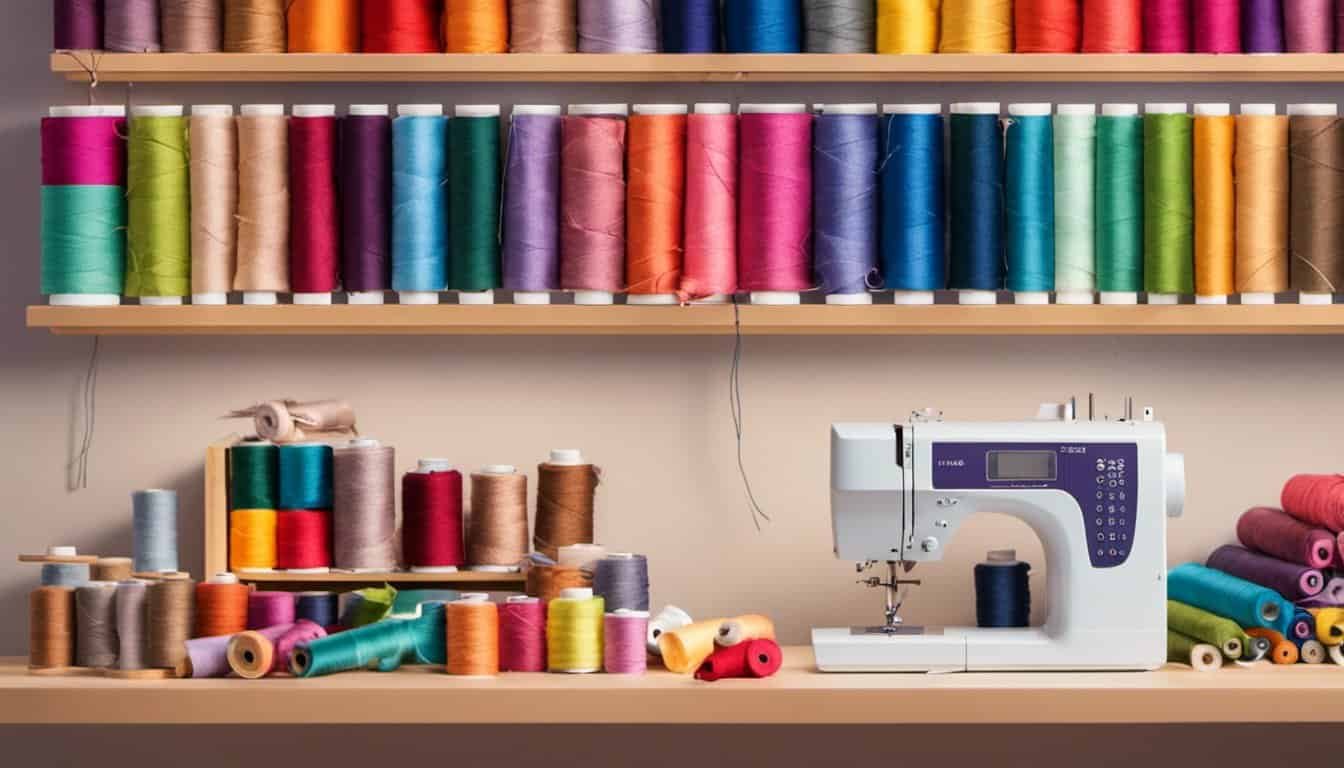
Denim
Denim is a heavy material that requires a strong needle and thread. A walking foot sewing machine can help to prevent the denim from slipping and ensure that the stitches are even. When sewing denim, it’s important to use a longer stitch length and avoid backstitching, as it can weaken the fabric.
Plaids
When sewing plaids, it’s important to match up the pattern at the seams. A walking foot sewing machine can help to prevent the fabric from shifting and ensure that the pattern lines up correctly. It’s also helpful to use a longer stitch length and avoid backstitching, as it can distort the pattern.
Overall, a walking foot sewing machine can be a valuable tool when working with heavier materials or thicker fabrics. By taking the time to adjust the stitch length and needle type, you can achieve professional-looking results on a variety of materials.
Budget-Friendly Walking Foot Sewing Machines
As someone who loves sewing, I know how important it is to have a reliable and efficient sewing machine. However, not everyone has the budget to buy an expensive machine. Luckily, there are some great budget-friendly walking foot sewing machines available that won’t break the bank.
Here are some of my favorite budget-friendly walking foot sewing machines that provide great value for money:
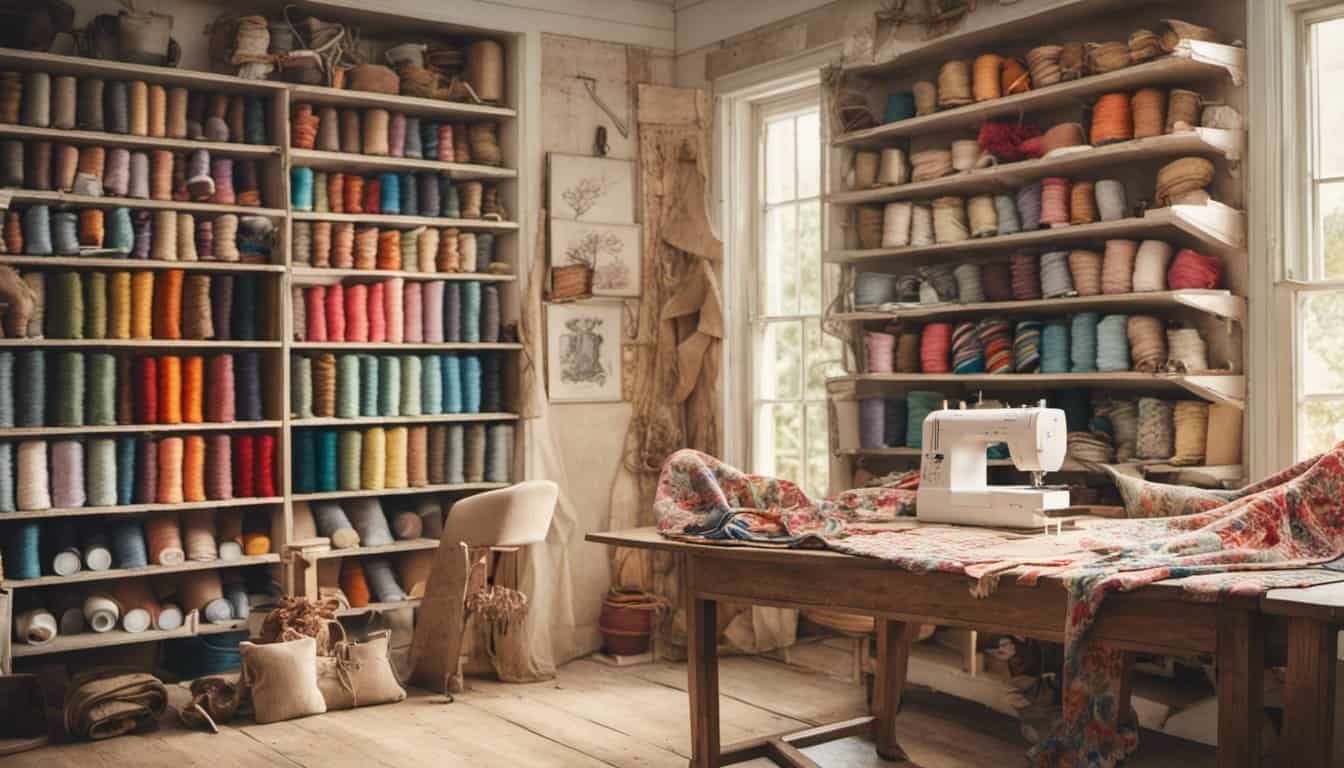
Brother CS6000i
The Brother CS6000i is an excellent budget-friendly walking foot sewing machine that is perfect for beginners. It comes with 60 built-in stitches, a LCD display screen, and an automatic needle threader. It also has a walking foot attachment that makes sewing thick fabrics a breeze. At its affordable price point, this sewing machine is definitely a great investment for those who are just starting out.
Singer Heavy Duty 4452
The Singer Heavy Duty 4452 is another great budget-friendly walking foot sewing machine that is perfect for those who love to sew thick fabrics like denim and leather. It comes with 32 built-in stitches, a heavy-duty metal frame, and a powerful motor that can sew through multiple layers of fabric. The walking foot attachment ensures that the fabric moves evenly through the machine, giving you a professional-looking finish every time.
Janome 2212
The Janome 2212 is a great budget-friendly option for those who want a simple and easy-to-use walking foot sewing machine. It comes with 12 built-in stitches, a front-loading bobbin system, and a free arm for sewing cuffs and sleeves. The walking foot attachment ensures that the fabric moves evenly through the machine, making it perfect for quilting and other heavy-duty sewing projects.
Singer 4423
The Singer 4423 is another great budget-friendly option that is perfect for those who want a heavy-duty sewing machine that can handle thick fabrics. It comes with 23 built-in stitches, a heavy-duty metal frame, and a powerful motor that can sew through multiple layers of fabric. The walking foot attachment ensures that the fabric moves evenly through the machine, giving you a professional-looking finish every time.
In conclusion, there are plenty of budget-friendly walking foot sewing machines available that provide great value for money. Whether you are a beginner or an experienced sewer, these machines are perfect for those who want to create professional-looking projects without breaking the bank.
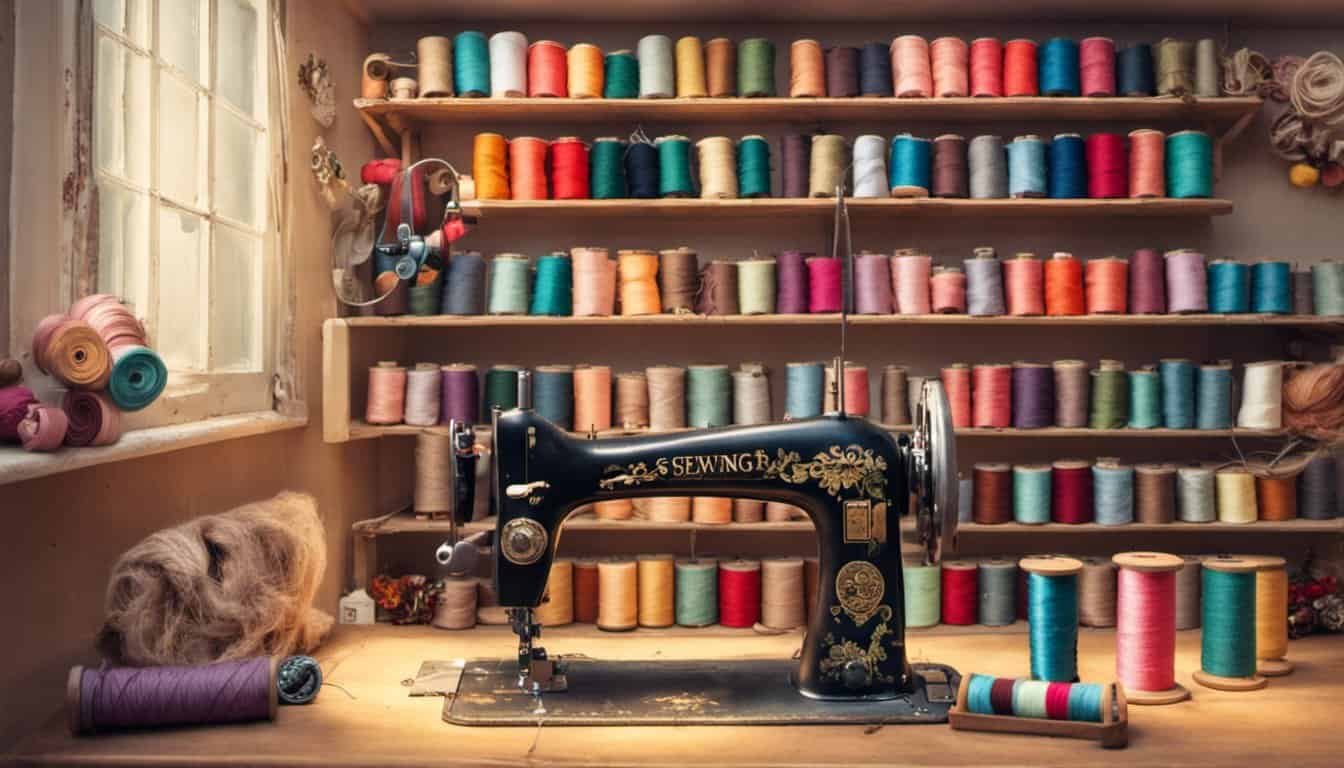
Industrial vs Domestic Walking Foot Sewing Machines
When it comes to walking foot sewing machines, there are two main types: industrial and domestic. Industrial walking foot sewing machines are designed for heavy-duty use in commercial settings, while domestic walking foot sewing machines are meant for home use. In this section, I will discuss the differences between the two types of machines.
Industrial Walking Foot Sewing Machines
Industrial walking foot sewing machines are designed for heavy-duty use in commercial settings. They are typically larger and more powerful than domestic machines, with a wider range of stitch options and the ability to sew through thick materials like leather, canvas, and upholstery. These machines are also built to last, with durable metal frames and high-quality components that can withstand years of heavy use.
One of the key features of industrial walking foot sewing machines is their triple-feed mechanism. This mechanism ensures that the fabric is fed evenly through the machine, preventing puckering or stretching. It also allows the machine to sew through multiple layers of fabric with ease.
Another advantage of industrial walking foot sewing machines is their speed. These machines can sew at much faster speeds than domestic machines, making them ideal for high-volume production settings.
Domestic Walking Foot Sewing Machines
Domestic walking foot sewing machines, on the other hand, are designed for home use. They are typically smaller and less powerful than industrial machines, with fewer stitch options and a lower maximum sewing speed.

While domestic walking foot sewing machines may not be as heavy-duty as their industrial counterparts, they are still capable of handling a wide range of sewing projects. They are ideal for sewing heavy fabrics like denim and canvas, as well as for quilting and other decorative stitching.
One advantage of domestic walking foot sewing machines is their portability. These machines are typically lightweight and easy to move, making them a great option for sewists who like to take their projects on the go.
In conclusion, the choice between an industrial and a domestic walking foot sewing machine depends on your specific needs. If you are running a commercial sewing business or need a machine that can handle heavy-duty materials, an industrial machine may be the best choice. However, if you are a home sewist looking for a versatile machine that can handle a wide range of projects, a domestic walking foot sewing machine may be the better option.
Maintenance and Durability
As someone who uses a walking foot sewing machine regularly, I know how important it is to keep your machine well-maintained to ensure its longevity. Here are some tips that I follow to keep my machine in good shape:
Regular Cleaning
One of the most important things you can do to keep your walking foot sewing machine running smoothly is to clean it regularly. I like to use a soft brush to remove any dust or lint that has accumulated on the machine. I also use a small vacuum attachment to clean out any hard-to-reach areas.

Lubrication
Another key aspect of maintaining your walking foot sewing machine is to ensure that it is properly lubricated. I use sewing machine oil to lubricate the moving parts of my machine, such as the bobbin case and the needle bar. It’s important to use a high-quality oil that is specifically designed for sewing machines, as other types of oil can damage the machine.
Durability
When it comes to durability, it’s important to choose a walking foot sewing machine that is built to last. Look for machines that are made from high-quality materials and have a solid construction. Some machines also come with warranties that can give you peace of mind knowing that you’re covered if anything goes wrong.
Overall, taking good care of your walking foot sewing machine is essential if you want it to last for years to come. Regular cleaning and lubrication can help keep your machine running smoothly, while choosing a durable machine can ensure that it can withstand the wear and tear of regular use.
Ease of Use
When it comes to sewing machines, ease of use is a crucial factor to consider. After all, no one wants to struggle with a complicated machine that takes forever to set up and use. Thankfully, the walking foot sewing machines available on the market today are designed with user-friendliness in mind.
One of the standout features of walking foot sewing machines is their ease of use. These machines are equipped with a walking foot that helps to move the fabric through the machine evenly. This means that even if you’re a beginner, you can achieve professional-looking results with ease.

Another factor that contributes to the ease of use of walking foot sewing machines is their intuitive design. Many of these machines feature simple and easy-to-understand controls that allow you to adjust the stitch length, tension, and other settings with ease.
In addition, many walking foot sewing machines come with a range of built-in features that make sewing a breeze. For example, some machines come with automatic needle threaders, which eliminate the need to thread the needle manually. Others come with built-in thread cutters, which make it easy to trim the thread after each seam.
Overall, the ease of use of walking foot sewing machines is one of their biggest selling points. Whether you’re a beginner or an experienced sewist, these machines are designed to make your sewing projects as easy and stress-free as possible.
Buyer’s Guide
When looking for the best walking foot sewing machine, there are a few things to consider. As someone who has been sewing for years, I have learned that choosing the right machine can make all the difference in the quality of your work. Here are some factors to keep in mind when making your decision.
Type of Fabric
The type of fabric you plan to sew is an important factor to consider when choosing a walking foot sewing machine. If you plan to work with heavy fabrics such as leather or canvas, you will need a machine with a powerful motor and a sturdy frame. On the other hand, if you plan to work with lighter fabrics such as cotton or silk, a machine with a lighter frame and less powerful motor may be sufficient.
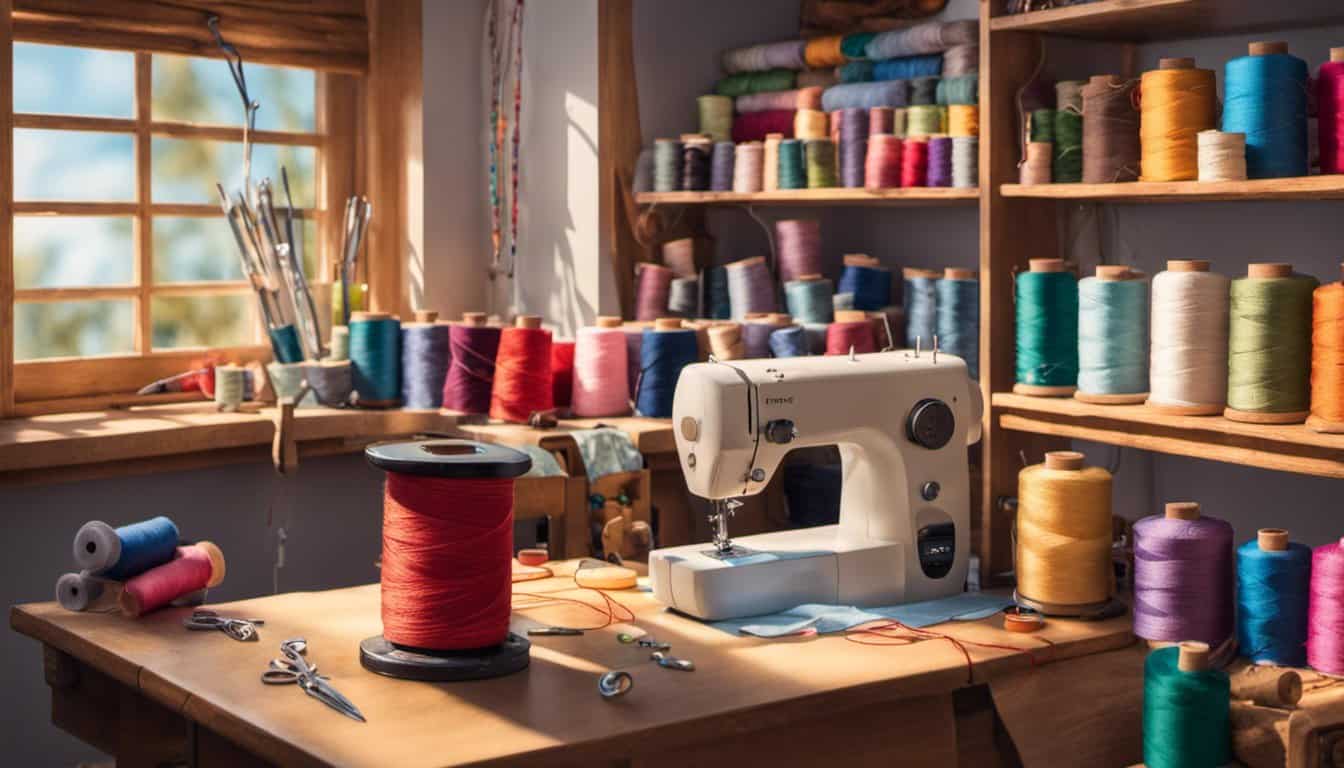
Machine Size
The size of the machine is another factor to consider. If you have limited space in your sewing area, a smaller machine may be more practical. However, if you plan to work on larger projects, a larger machine may be necessary to accommodate the size of the fabric.
Machine Features
Walking foot sewing machines come with a variety of features, and it’s important to choose a machine that has the features you need. Some features to consider include:
- Adjustable stitch length and width
- Automatic needle threader
- Built-in thread cutter
- Bobbin winder
- Reverse stitch function
- Speed control
Brand and Price
The brand and price of the machine are also important factors to consider. While it may be tempting to choose a cheaper machine, it’s important to remember that you get what you pay for. Investing in a higher quality machine from a reputable brand can save you money in the long run by lasting longer and requiring fewer repairs.
In conclusion, when choosing a walking foot sewing machine, it’s important to consider the type of fabric you plan to sew, the size of the machine, the features it offers, and the brand and price. By keeping these factors in mind, you can choose a machine that will meet your needs and help you achieve the best possible results.
Comparison Table
When it comes to finding the best walking foot sewing machine, it can be overwhelming to sort through all the options available. That’s why I’ve put together a comparison table of the top models to help make your decision easier.

| Model | Features | Pros | Cons |
|---|---|---|---|
| Brother CS6000i | 60 built-in stitches, LCD display, automatic needle threader | Affordable, versatile, easy to use | Not suitable for heavy-duty projects |
| Singer Heavy Duty 4452 | 32 built-in stitches, extra-high sewing speed, heavy-duty metal frame | Powerful, durable, great for thick fabrics | Some users report tension issues |
| Consew 206RB-5 | Compound feed walking foot, large bobbin, adjustable stitch length | Ideal for heavy-duty projects, reliable, precise | Expensive, not suitable for beginners |
| Yamata FY-1541S | Compound feed walking foot, servo motor, adjustable stitch length | Great for leather, canvas, and upholstery, reliable | Expensive, not suitable for beginners |
| Juki DNU-1541S | Single-needle walking foot, maximum sewing speed of 2,500 stitches per minute, large bobbin | Excellent for leather, upholstery, and heavy fabrics, reliable | Expensive, not suitable for beginners |
| Consew P1206RB | Compound feed walking foot, adjustable stitch length, large bobbin | Great for leather, upholstery, and canvas, reliable | Expensive, not suitable for beginners |
| Juki LU-1508NS | Single-needle walking foot, maximum sewing speed of 2,500 stitches per minute, large bobbin | Ideal for leather, upholstery, and heavy fabrics, reliable | Expensive, not suitable for beginners |
Each of these models has its own unique set of features, pros, and cons. Consider your specific needs and budget when making your decision.
Conclusion
After researching and reviewing the top walking foot sewing machines on the market, I have come to the conclusion that there is no one-size-fits-all solution. The best walking foot sewing machine for you will depend on your specific needs and preferences.
If you are a beginner or looking for a budget-friendly option, the Brother CS6000i is a great choice. It has a walking foot and is easy to use, making it perfect for those just starting out.
For heavy-duty projects, the Singer Heavy Duty 4452 is a reliable option. It has a powerful motor and can handle thick fabrics with ease.
If you need an industrial-grade machine, the Consew 206RB-5 is a popular choice. It has a triple feed walking foot and can handle a variety of materials, including leather and upholstery.

The Yamata FY-1541S is another heavy-duty option that is great for sewing thick fabrics. It has a walking foot and can handle a variety of materials, making it versatile and reliable.
Overall, when choosing a walking foot sewing machine, it is important to consider your specific needs and preferences. Whether you are a beginner or an experienced sewer, there is a walking foot sewing machine out there for you.
Frequently Asked Questions
What are some affordable options for a walking foot sewing machine?
If you’re on a budget, you can still find a good walking foot sewing machine. The Brother CS6000i is a popular option and is known for its affordability. Another option is the Singer Heavy Duty 4452, which is a heavy-duty machine that won’t break the bank.
What are some reputable brands for walking foot sewing machines?
There are several reputable brands for walking foot sewing machines. Some of the most well-known brands include Juki, Singer, and Brother. Other brands to consider include Consew, Yamata, and Rex.
Where can I find used walking foot sewing machines for sale?
You can find used walking foot sewing machines for sale on websites like eBay, Craigslist, and Facebook Marketplace. You can also check with local sewing machine repair shops or sewing machine dealerships to see if they have any used machines available.
Are there any industrial walking foot sewing machines for sale near me?
If you’re looking for an industrial walking foot sewing machine, you may need to do some research to find a dealer near you. Some industrial sewing machine dealerships have locations in multiple cities, so it’s worth checking to see if there’s a dealer near you. You can also look for used machines on websites like eBay or Craigslist.
Which sewing machines come with a built-in walking foot?
Not all sewing machines come with a built-in walking foot. However, some machines do have a walking foot attachment that can be purchased separately. Some machines that come with a built-in walking foot include the Janome Memory Craft 6600P and the Juki TL-2010Q.
Is a sewing machine with a walking foot better for quilting projects?
A sewing machine with a walking foot can be beneficial for quilting projects because it helps to feed the layers of fabric evenly. However, it’s not necessary to have a walking foot for quilting. Many quilters prefer to use a free-motion quilting foot or a darning foot for more control over their stitches.

